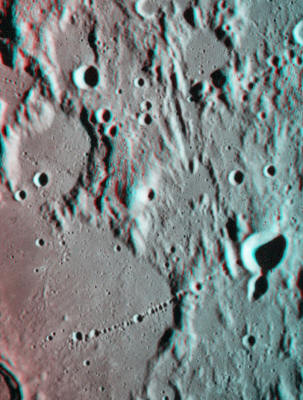|
by Stephen Smith
Firdousi, a rampart crater (center) on Mercury, illustrates electric arc erosion.
Credit: NASA/Johns
Hopkins University Applied Physics Laboratory/Carnegie Institution
of Washington MESSENGER entered orbit around Mercury on March 17, 2011 after traveling nearly eight billion kilometers.
Since that time, it has sent hundreds of close-up images of the surface, revealing features and topography that assure Mercury's kinship with the Solar System's other celestial bodies:
Past electrical activity on Mercury is evident in several locations around the planet.
Indeed, the entire planet could be said to exhibit nothing but electrical effects.
The etched furrows (above image) radiating
outward from some craters, such as
Firdousi, above, denote the path
of untold numbers of electric filaments as they danced a fiery dance
across the surface. On Earth, those filaments would have been the
largest lightning strikes ever witnessed.
He created radial gouges (above image) on a small scale equivalent to Mercury at the large scale.
As pointed out in previous Pictures of
the Day, Nobel Laureate Hannes Alfvén thought that electrical
(plasma) phenomena could be scalable by as much as 14 orders of
magnitude.
One of those ways would be to act like a plasma "drill bit," cutting steep crater sidewalls, while sometimes leaving a “pinched up” mound in the center. Multiple filaments would cut one crater within another, often with one or more craters on the rims.
Firdousi, among dozens of other large craters
(below image) on Mercury,
conforms to that insight.
What is most remarkable about Mercury and other members of the Solar System are the numerous crater chains that abound throughout the population.
From Phobos (above image) to Phoebe; from Mars to Miranda, planets and moons are pocked with holes (below image 1) that run in long lines (below image 2), sometimes for hundreds of kilometers.
image 1
image 2
The common explanation for them is that a string of meteoroids impacted one after another, one behind the other.
The necessary coincidence for that effect notwithstanding,
the absence of distortion in adjoining crater walls calls the theory
into question. Add to that the twists, turns, loops, and braids that
can be seen in many of them and the idea that rocks falling from
space caused these features falls apart.
A Jacob's ladder is constructed by placing a stiff copper wire on each standoff of a neon sign transformer and then bending them in toward each other until they form an ever-widening "V" from bottom to top.
When the
current is turned on, an electric arc begins at the lowest level of
the V and then rises up to the top, growing longer across the
widening gap until it disconnects with a snap, only to immediately
begin again. If a piece of paper is held between the two limbs of
the V while the electric arc travels upward, a row of pinholes will
be found burned lengthwise into the paper.
It is certain that additional evidence supporting
the new
Electric Universe paradigm will come to light.
|







